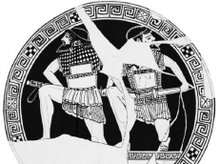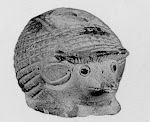The Aspis: Surviving Hoplite Battle.
Agiselaos II of Sparta stood victorious on the battlefield of Koronea in 394 B.C. when he learned that the Thebans had defeated his allies and were looting his baggage train. Showing more bravery than tactical sense, he formed his phalanx directly across the Theban line of retreat rather than taking them in the flank or rear as they passed. Sources do not reveal how many ranks of hoplites faced each other in this struggle, but the Spartans likely formed in 12, while the Thebans may have formed as they had at Delium, in 25 ranks, for a similar breakthrough attempt. The Spartan force, “…crashed against the Thebans front to front: and setting shields against shields they pushed, fought, killed, and were killed.” (Xenophon, Hellenica 4.3.19). The Spartans were victorious, but the Theban loss obscures the fact that their extra-deep phalanx broke through the Spartan phalanx. A description of the aftermath of the battle conveys the brutality of the clash: “a weird spectacle met the eye… the earth stained with blood, friend and foe lying dead side by side, shields crushed to pieces, spears snapped in two, daggers bared of their sheaths, some on the ground, some embedded in the bodies, some yet gripped by the hand.” (Xenophon, Agiselaos 2.1.14).
What Xenophon described is the result of a phase of hoplite battle termed Othismos. The term implies “pushing”, and has traditionally been taken to mean a clash between the massed ranks of hoplites where the goal was literally to push back the other formation until it broke due to a loss of cohesion and failure of morale.
The mechanics, and even existence, of this mass-scrum have been hotly debated over the last half-century in a series of papers whose titles imply nothing less than a protestant revolution. One proponent of the “heretical” view points out that no other army fought through such a pushing match: “Should it be proved that the othismos really was a contest of massed shoving…It would be necessary to explain how the Greeks were able to fight in this unique way, and why they did so.” (Goldsworthy)
The answer to Goldsworthy’s challenge lies in understanding the hoplite shield, which is often referred to as a hoplon and seen as lending its name to the hoplite. However, the term hoplon can refer to any implement of war. The specific term is aspis and sometimes rendered as Argive aspis, although the connection to Argos, either as originator or mass- producer, is unclear. The shield may have originated as early as the late 8th or early 7th century B.C. and survived in nearly identical form for at least three hundred years.
Round to slightly oval in outline, normally 80 cm to 1 m in diameter and about approximately 7.5 kg weight, its characteristic features are a convex profile and a robust, offset outer rim. A surviving Etruscan example in the Museo Gregoriano of the Vatican that appears similar to less well preserved examples from Greece was constructed of 20-30 cm poplar wood planks glued together horizontally to form a solid block, then turned on a lathe to form the characteristic shallow dome shape that left the flattened center of the core thinner than the curving outer edges. This shield has a diameter of 82cm, a depth of 10 cm and a 4.5 cm off-set rim reinforced with wooden laminates. Construction methods may have changed with time because shields represented on the 7th century Chigi vase appear to be made of layers of thin wooden laths. The shield’s inner face was usually covered with leather and sometimes highly decorated. The face of the Vatican shield is covered in a seamless .5 mm layer of bronze that overlaps the inner face of the rim by 4 cm. This fully bronze-faced front of the shield is commonly portrayed, but archaeological finds show that bronze plating of the rim alone, perhaps with a bronze blazon, was more common. Some depictions show additional metal bands reinforcing the inner face of the shield.
In use the aspis was supported by a double grip system. At the center of the shield’s concave interior was a bronze loop, the Porpax, through which the left forearm was placed to bear the weight of the shield. The porpax was secured to the shield’s inner face by long vertical bronze straps. This structure could be one piece or made so that the armband was removable, as the Spartans are said to have done to render their shields unusable to rebellious Helot serfs. A second grip, the antilabe, was for the left hand and was placed near the rim. The grip was a pair of metal staples through which a rope passed that traveled through four or more metal rings spaced around the inside perimeter of the shield.
This peculiar shield’s evolution is not well understood. Round, bronze-faced shields were common in the region prior to its appearance, but these were generally single-grip and did not display the twin features of domed shape and off-set rim. Assyrian infantry carried large, deeply convex shields of bronze, but they had a single grip and were cone-shaped. Urartian bronze shields, which have been excavated at Toprakkale near Lake Van in Anatolia, were domed with offset rims. Their diameter, 77 cm to 1 m, differed little from hoplite shields. These had a triple-grip system that has been interpreted to be a single hand grip and two points of attachment for a neck strap or telamon, but may have influenced Greek design.
Much attention has been paid to the convex shape of the aspis. Convex or sloped armor presents a greater thickness of wood to be penetrated by weapons impacting at oblique angles. This fact alone might explain the convex Assyrian shields, for their cone shape is the optimal profile to maximize this effect. The Greek shield is less well adapted for this, since the greatest slope is relegated to a small area at the outer edge, while the broad face of the shield is a shallow curve. Curvature also insures that chopping weapons will be impact on a broad area rather than biting into the rim of a shield. The semi-cylindrical examples of the Roman scutum may be made for this, but in the aspis the curvature by being confined to a narrow band at the edges is too extreme to maximize this form of protection and the robust rim would seem to negate its necessity. That the aspis is thinner at its center than at the edges differs from other shield types and indicates that protection from penetration was not the only factor in its design.
The uniqueness of this shield is apparent if we analyze it from a structural engineer’s perspective. A domed profile can support great weight without collapsing and indicates a load-bearing function. The dome of the aspis is shallow and less efficient, so increased force on the flattened surface will cause the rim will be thrust outward. Trusses or supports that resist this outward force are needed to keep the shallow dome from popping inside out like an umbrella in the wind. In the aspis, this was accomplished by its thickened rim. The off-set design presents the maximum thickness of wood against the force attempting to push the rim outwards. A bronze sheath adds to this as the tensile strength of the metal resists stretching. On some depictions, narrow metal reinforcements are seen around the inner surface. These add little protection, but would aid greatly in supporting the integrity of the load-bearing dome. The enigmatic rope that runs around the inner surface and forms the antilabe may have had its origins as a cable truss to add additional support to the inner face of the dome. The Greeks used such cable trusses, upozwmata, to keep their ships from bending up in the center, or "hogging," from pressure on the hull.
Friday, October 17, 2008
Subscribe to:
Post Comments (Atom)





1 comment:
one must remember that Greece is a mostly VERY mountainous country. And was a terrain ruled as a number of independant "city states" by different Greek tribes. Each City State controlled the local valley(s) or plateau, but they were separated from one another by narrow mountain passes, in the boarder areas. The Phalanx "shove of war" (Othismos)would arise spontaneously as a dynamic of battle, where even with large numbers of warriors, only a limited number could engage the enemy face to face at the battle front. Therefore the shields were developed to better perform as a battering ram, sturdier in grip (a revolutionary developement) & robust, heavy and inflexable.
To see how restricted this made access to any given area in Greece see youtube video analysis of the attempted Persian Invasion of Greece by Xerxes in c.480 BC. http://www.youtube.com/watch?v=1Q8MF6I9Tw4
Post a Comment